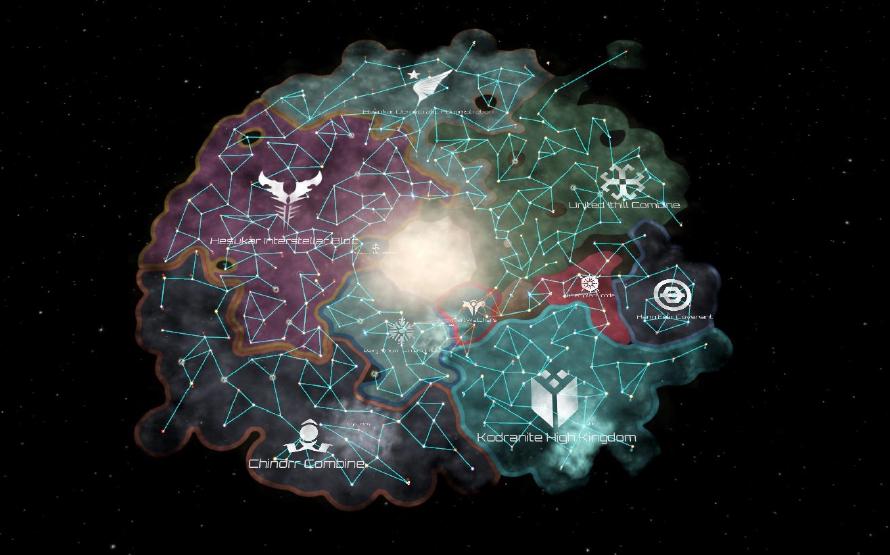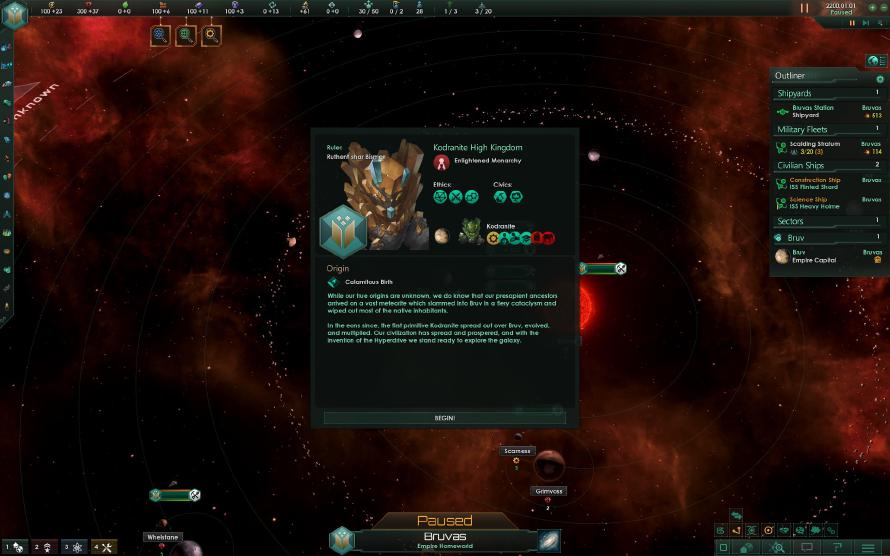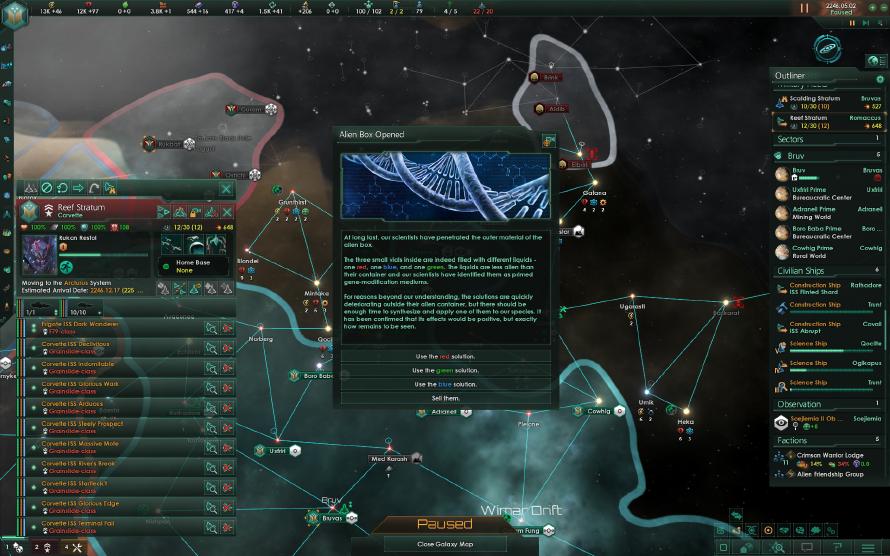Stellaris: Federations
I used to play a lot of Stellaris. It’s by far the game I’ve wasted1 the most time on, with 214 hours of game time before I sat down to play for this reviews. The early versions of the game were my favorites. The game was simple and straightforward to learn, and relatively easy to master. But with the release of Stellaris version 2.2, and the accompanying MegaCorp expansion, a lot of the game’s core game mechanics changed. For many people, in particular the typical hard core strategy gamers that tend to gravitate towards Paradox titles, the changes were welcome.
But I never managed to get comfortable with them. The level of micro management that was required went through the roof, the UI changed for the worse, and the entire game just got more complicated. Too complicated for me. I want to think of myself as an advanced strategy gamer, but the truth is that I prefer simple games like the classics Command & Conquer, Homeworld, Civilization, and Age of Empires II. I’ve not yet admitted this to myself, so I own copies of (and most of the available DLC) for Crusader Kings II, Hearts of Iron IV, and Europa Universalis IV. Total playing time for all three games? 15 hours.
Since I last reviewed Stellaris more than a year ago, Paradox has released version 2.7, and a brand new expansion, Federations. Can the new expansion and all the changes in the versions since 2.2 revive my interest in the game?
Same Old, Same Old?
For my review play-through, I wanted to play as the Lithoids, a race that was added in a DLC released back in 2019. Lithoids are a bigger and boulder species type made entirely of sapient rock who eat minerals for sustenance, are long-lived, and can colonize in almost any environment.
I’m usually a big-ass turtler when I play computer games. My tactic is that I want trouble to come to me, instead of trying to find it, and I only go on the offence as a last resort or if I’m getting bored. This time, however, I decided to play as an offensive militarist empire, just to spice things up a little. Since the Lithoids eat minerals, a resource that is used for a lot of different things in Stellaris, I focused on civics and traits that would increase my the Lithoids’ ability to mine them.
During empire creation, I discovered at least one new feature; Origins. The Origin represents the background of a species before it unified itself into an empire. It’s a nice addition to the game, particularly if you’re of the role playing type. I decided to give my empire, the Kodranite High Kingdom, the Calamitous Birth origin. It’s unique to the Lithoids, and grants some handy home world bonuses.
One annoying change Paradox made to Stellaris at some point was to change the victory condition. In the earlier versions of the game, you could win the game if you owned 40% of the galaxy’s habitable worlds, or conquered or subjugated all other empires. In version 2.2 of Stellaris, this was changed into a victory score determined when the game reached a specific year. This is a way to determine victory that’s familiar to players of other Paradox titles. But it’s not a victory condition I find particularly interesting since it’s not connected to a particular goal, but rather a point in time. Why not let the player choose between both kinds of victory conditions?
For my game, I turned off the victory year. In hindsight, this might have been a less-than ideal thing to do, since it looks like I’ve disabled victory as an event altogether.
Life of the Kodranites
One very good thing about Stellaris is that no game is the same. And this play-through turned out to be no exception to that rule.
It quickly became apparent that I was landlocked, blocked by a marauder empire and an empire of Holy Guardians to the North, and a choke point leading to another empire to the West. The area I had access to wasn’t half bad in size, though, so I managed grow into the second largest empire in the galaxy. I also had plenty of resources to pay tribute to the marauders, and made peace with the empire to the West2.
So life in my quadrant of the galaxy was pretty peaceful. I had to handle a Shard and an Ether Drake, but it wasn’t anything the proud Kodranites couldn’t handle without a little planning.
But when the mid-game arrived I ran into some serious problems. The marauders to the North united under The Great Kahn, and organized into The Horde. The Horde is a very aggressive bunch, and isn’t satisfied with just receiving tribute. Instead, they want to rule the galaxy, and throw all their power behind the task. I had tried to prepare for an event like this by blocking the choke points with star fortresses. Unfortunately, I hadn’t built any defence platforms, the reason being that I’d forgot that they even existed.
My star fortresses didn’t stand a chance as The Horde entered the systems with fleets 4 times more powerful, and steam rolled over everything. It quickly became obvious that this was not a fight the Kodranites could win, and the empire surrendered to The Horde. The Kodranite High Kingdom is now a satrapy of The Horde. It has to surrender a considerable portion of its resources to The Horde, but other than that the Kodranites are pretty much allowed to do as they will.
At this point, it was tempting to give up, but also tempting not to. There’s a good chance I’ll pick up where I left the Kodranite High Kingdom in the not-so-distant future.
Final Thoughts
Since it’s a long time since I last played Stellaris, it’s hard for me to spot everything that has changed since version 2.2. But I can say this: Whatever changed, it’s for the better, and the game certainly feels like it’s more fun than it used to. My current play-through has kept me entertained for 15 hours, and I suspect there are plenty more hours in there when I find the time to return to the game.
Stellaris is still the game I would pick if I was sent off to a remote island, and only was allowed to bring a single game with me. If you want to play a game that blends the 4X, sci-fi, and grand strategy genres, Stellaris would be a great choice. It’s not as accessible as it used to be, but if you take the time to get to know all the game mechanics, and the pretty mediocre user interface, you’ll be thoroughly rewarded.

This review is based on 15 hours of gameplay with the 2.7.1 patch with the following DLC and expansions installed: MegaCorp, Distant Stars Story Pack, Apocalypse, Humanoid Species Pack, Synthetic Dawn, Utopia, Leviathans Story Pack, Plantoids Species Pack, Creatures of the Void, Horizon Signal, Lithoids Species Pack, Ancient Relics Story Pack, and Federations. Before playing for this review, I’d played various versions of Stellaris and its DLC and expansions for 214 hours.
Is it a waste of time, though? No, it’s not. ↩︎
Yes, I ended up turtling again. ↩︎
Feedback
This post has no feedback yet.
Do you have any thoughts you want to share? A question, maybe? Or is something in this post just plainly wrong? Then please send an e-mail to vegard at vegard dot net with your input. You can also use any of the other points of contact listed on the About page.

